International space happenings.
...
Three Space Station Crew Members Return to Earth, Land Safely in Kazakhstan
Three crew members from the International Space Station returned to Earth at 5:15 a.m. EDT (3:15 p.m. Kazakhstan time) Saturday after wrapping up 186 days in space and several NASA research studies in human health.
Expedition 47 Commander Tim Kopra of NASA, flight engineer Tim Peake of ESA (European Space Agency) and Soyuz Commander Yuri Malenchenko of Roscosmos touched down southeast of the remote town of Dzhezkazgan in Kazakhstan
The crew completed the in-flight portion of NASA human research studies in
ocular health,
cognition,
salivary markers and
microbiome. From the potential development of vaccines, to data that could be relevant in the treatment of patients suffering from ocular diseases, such as glaucoma, the research will help NASA prepare for human long-duration exploration while also benefiting people on Earth.
The three crew members also welcomed four cargo spacecraft, including one that delivered the
Bigelow Expandable Activity Module (BEAM), an expandable habitat technology demonstration. The BEAM, which arrived in April on the eighth SpaceX commercial resupply mission, was attached to the space station and expanded to its full size for analysis over the next two years. The BEAM is an example of NASA’s increased commitment to partnering with industry to enable the growth of commercial space, and is co-sponsored by the agency’s Advanced Exploration Systems Division and Bigelow Aerospace.
Two Russian Progress cargo craft docked to the station in December and April, bringing tons of supplies. Kopra and Peake also led the grapple of Orbital ATK’s Cygnus spacecraft to the station in March, the company's fourth commercial resupply mission, and the SpaceX Dragon spacecraft in April.
During his time on the orbital complex, Kopra ventured outside for two spacewalks. The objective of the first spacewalk was to move the station’s mobile transporter rail car to a secure position. On the second spacewalk, Kopra and Peake replaced a failed voltage regulator to restore power to one of the station’s eight power channels. Kopra now has 244 days in space on two flights, while Peake spent 186 days in space on this, his first, mission.
Having completed his sixth mission, Malenchenko now has spent 828 cumulative days in space, making him second on the all-time list behind Russian cosmonaut Gennady Padalka.
Expedition 48 continues on the station, with NASA astronaut Jeff Williams in command, with crewmates Oleg Skripochka and Alexey Ovchinin of the Russian space agency Roscosmos. The three-person crew will operate the station for three weeks until the arrival of three new crew members.
NASA astronaut Kate Rubins, Russian cosmonaut Anatoly Ivanishin and Takuya Onishi of the Japan Aerospace Exploration Agency are scheduled to launch July 6 (Eastern time) from Baikonur, Kazakhstan.



 . Blue Origins who
. Blue Origins who ?
?





 !!
!!






















 - the SLS booster test can be seen here at 9:30 to 10:30 AM Eastern Standard Time:
- the SLS booster test can be seen here at 9:30 to 10:30 AM Eastern Standard Time:












